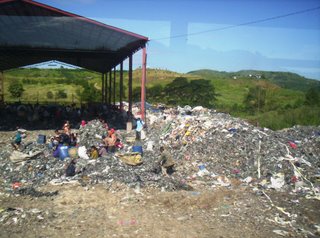
"May pera sa Basura." That was how we were welcomed by Engineer Mendoza of the Metro Clark Waste Management Corporation. All of us listened to his orientation. We were inside an air conditioned office space. On one side were trees of all kinds, on the other is a man-made lake and beside it is a mountain. The mountain was actu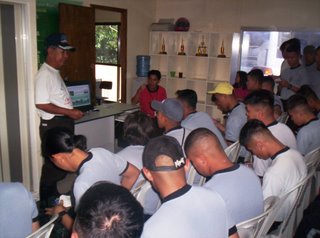 ally a huge pile of garbage and the lake beside it was its juice that they call leachate.
ally a huge pile of garbage and the lake beside it was its juice that they call leachate.
 ally a huge pile of garbage and the lake beside it was its juice that they call leachate.
ally a huge pile of garbage and the lake beside it was its juice that they call leachate.Solid waste management has been a perrenial problem. Not just because of the fact that it is waste but also because it is something that is very visible, it is an eye sore. I remember the days when I had to accompany my mother going to Marikina Market. It was during the pre-Bayani Fernando days. When all the vendors begin to sell their products, all the garbage also begins to appear. I hated it. First the water becomes black, then my slippers becomes dirty with the black water, my feet begins to be slippery with the dirt and water combined. By the time it is time to go home, my feet feels (and smells) so bad that I promise myself not to go with my mother again. Well, things did change, lately Marikina has been making good in this area. Going there now, it becomes a pleasant visit and a worthy example of how things are if 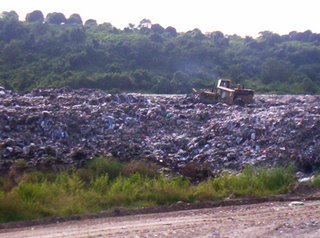 only people have more responsibility at disposing their garbage.
only people have more responsibility at disposing their garbage.
 only people have more responsibility at disposing their garbage.
only people have more responsibility at disposing their garbage.The orientation continued and then we were given the tour to the site including going to the actual garbage. I realized how our little trashes can grow into huge mountains like the ones in front of me. For most of us, we just do not care and yet we complain of floods, of diseases and other things that have some connection with garbage. The mountain of garbage reminded me of a sense of responsibility in the things that we do.
The next place we went to was Trust International 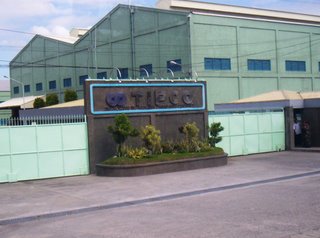 Paper Corporation or TIPCO. It is the largest paper mill in the country and prides itself as the leading supplier of newsprints in the country. Most likely each of us have taken hold of the paper they produce because they are the ones who provide the paper of almost all leading newspapers in the country. What is interesting in this plant is that they use 100 percent waste paper for their products.
Paper Corporation or TIPCO. It is the largest paper mill in the country and prides itself as the leading supplier of newsprints in the country. Most likely each of us have taken hold of the paper they produce because they are the ones who provide the paper of almost all leading newspapers in the country. What is interesting in this plant is that they use 100 percent waste paper for their products.
 Paper Corporation or TIPCO. It is the largest paper mill in the country and prides itself as the leading supplier of newsprints in the country. Most likely each of us have taken hold of the paper they produce because they are the ones who provide the paper of almost all leading newspapers in the country. What is interesting in this plant is that they use 100 percent waste paper for their products.
Paper Corporation or TIPCO. It is the largest paper mill in the country and prides itself as the leading supplier of newsprints in the country. Most likely each of us have taken hold of the paper they produce because they are the ones who provide the paper of almost all leading newspapers in the country. What is interesting in this plant is that they use 100 percent waste paper for their products.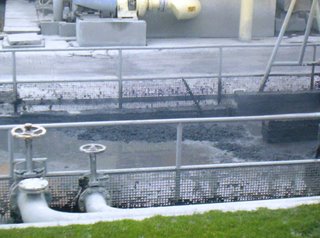
Mr Rox Pena, a manager in TIPCO, was the one who brought out the comment on garbage being the most visible pollutant such that it has to be addressed. In his little lecture he said that around 40 percent of all the garbage collected in the country is waste paper and yet his company is not able to retrieve that such that they still have to import waste paper from countries as far as the United States. Imagine how more profitable it is if only we have a system that will retrieve all this waste paper. More than how the paper is made, I took particular attention to their water treatment facility. This ensures that their waste water will not cause harm to society instead it has been used in other useful means. Their fire s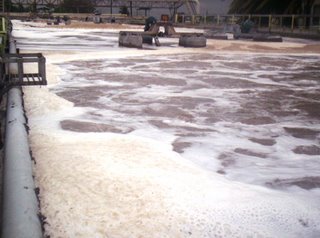 tation boasts of using treated water to put off fires and they have hollowblocks made of clay from their treated water. I guess what is very evident in what they are doing is the sense of responsibility not just for their own personal gain but for the benefit of the wider community.
tation boasts of using treated water to put off fires and they have hollowblocks made of clay from their treated water. I guess what is very evident in what they are doing is the sense of responsibility not just for their own personal gain but for the benefit of the wider community.
 tation boasts of using treated water to put off fires and they have hollowblocks made of clay from their treated water. I guess what is very evident in what they are doing is the sense of responsibility not just for their own personal gain but for the benefit of the wider community.
tation boasts of using treated water to put off fires and they have hollowblocks made of clay from their treated water. I guess what is very evident in what they are doing is the sense of responsibility not just for their own personal gain but for the benefit of the wider community.It is true that there really is money in garbage but more than finding money we should also remember that in everything we do, we should couple it wit a sense of responsibility. Not because it is being good but because it is only by being responsible that we can sustain this world for us to endure and continue living.
Tomorrow, I will introduce you to the birds of Candaba Swamp in Pampanga... till then

No comments:
Post a Comment